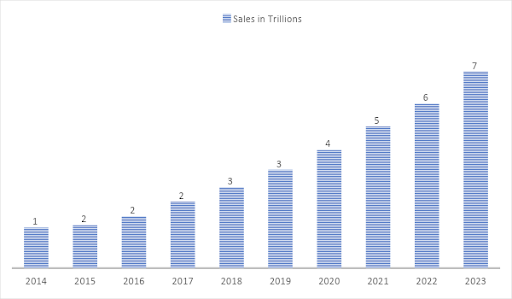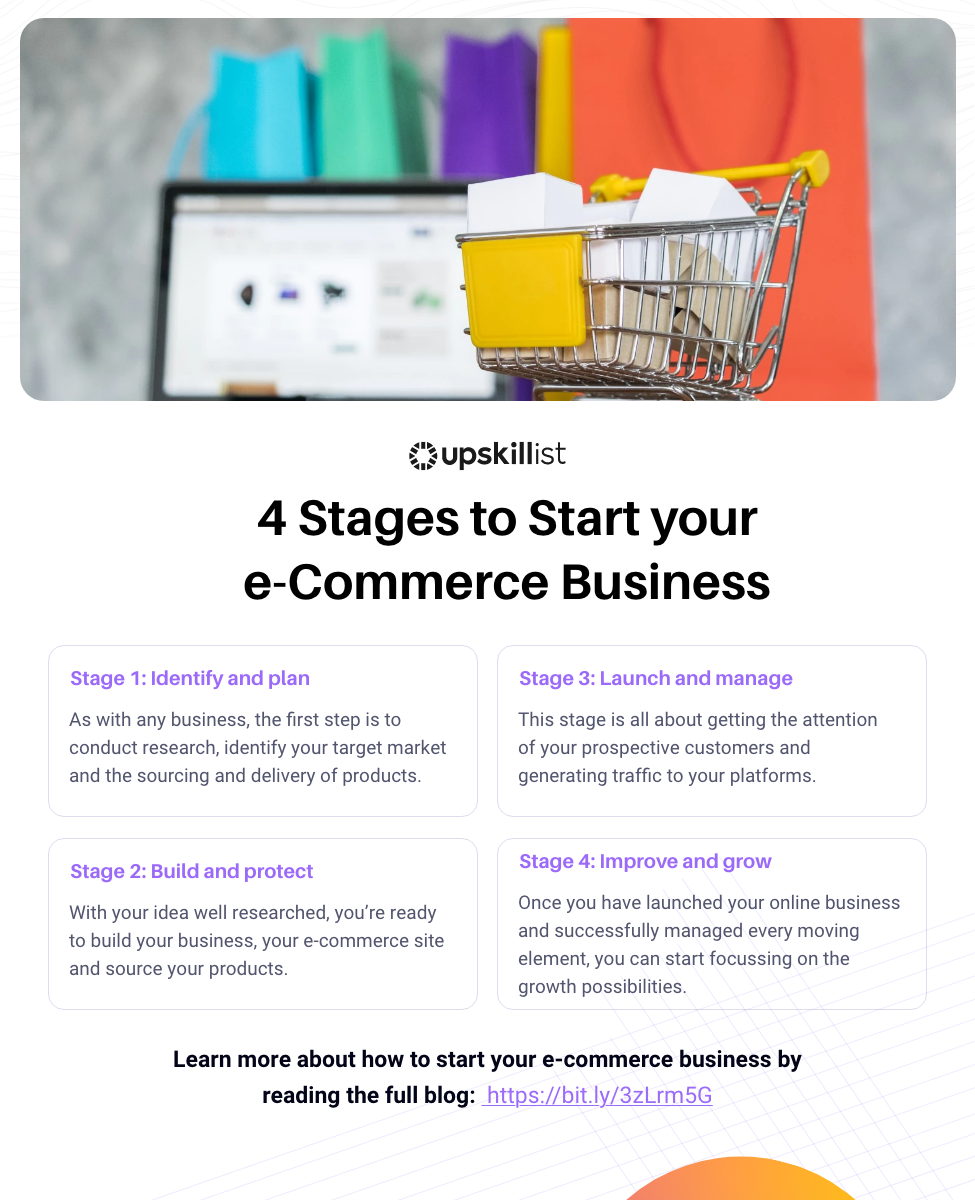
How to start your e-commerce business
Fuelled by the introduction of innovative technologies and changes in consumer shopping-related behaviours, e-commerce is a thriving industry and there is no better time to join the community than now.
Did you know that:
- 61% of baby boomers are digital buyers
- 78% of Generation Xers are digital buyers
- 81% of millennials are digital buyers
This means that a large percentage of the world population is interested and willing to partake in e-commerce, making it an opportune time for you to start your e-commerce business.
Here is what you need to know about starting an e-commerce business, and what we cover in this blog:
What is an e-commerce business?
Before we dive into how to start your e-commerce business, let’s quickly define e-commerce.
e-Commerce, refers to the buying and selling of goods and services over the internet, usually websites.
Did you know you also get m-commerce and s-commerce?
These are, now more than ever, invaluable support tools allowing you to market your products and services through mobile applications (m-commerce) and social media platforms (s-commerce).
Every time participants buy or sell online, whether using computers, mobile devices or social media platforms they are engaging in e-commerce. This means that in terms of potential customers, you can, as of January 2022, reach 62.5% of the global population.
Types of e-commerce
There are three elements to your e-commerce business that require investigation up front.
- Who are the key members of your business?
- What is your offering?
- What structure will be used to deliver your offering?
The type of e-commerce structure that will work for you will depend on a number of factors including your service or product offering, the initial investment and funding available as well as target markets. Be sure to choose a model that works for your big picture.
Firstly let’s consider the members of your e-commerce business. There are five e-commerce models to consider
Business to Business (B2B) | With the B2B model, the business supplies products or services to other businesses. | For example:
|
Business to Consumer (B2C) | With a B2C structure, the business provides services or products to the consumers using online facilitates. | For example:
|
Consumer to Consumer (C2C) | This model allows consumers to trade, buy and sell items to other consumers. | For example:
|
Consumer to Business (C2B) | A growing interest is the consumer to business models which is where consumers sell goods or services to businesses. | For example:
|
Business to Government (B2G) | B2G businesses provide specialised services to the government. | For example:
|
There are broadly four types of offerings.
Physical products | A tangible product that the consumer can hold in their hands. | For example:
|
Digital products | An intangible product that the consumer can stream or download and translate into a physical medium. | For example:
|
Physical services | The direct engagement between the consumer and the business. | For example:
|
Digital services | The consumption of intangible activities via an online platform. | For example:
|
In terms of sourcing and delivering your products the following approaches should be considered.
Direct to consumer | This approach means you’re selling directly to your customer without the involvement of a middleman. |
Drop shipping | This enables you to partner with a wholesale supplier who has the capacity to both hold inventory and deliver items to your consumers directly. |
Warehousing | With this approach you would purchase the products from a manufacturer, hold inventory and control delivery to your customer. |
White labelling | The white label approach enables you to purchase generic products from a manufacturer and promote them under your own brand identity. |
Private labelling | Here you can outsource your manufacturing but with product specifications and prototypes to promote products under your own brand identity. |
How to start an e-commerce business
Starting and growing your e-commerce business is easy when broken up into four stages.
Stage 1: Identify and plan
As with any business, the first step is to conduct a little research. Maybe you already have a product or service in mind, maybe you already have a platform in mind as well as a business model, but do you know your competition? Do you know your target market? Do you know how you will be sourcing and delivering your products?
Did you know that there are currently over 26 million e-commerce sites in the world. Even with the world as your potential market it is important to stand out among the 26 million e-commerce sites already established and the best way to do this is to find your place from the start. This is what stage 1 is all about, finding your niche.
Step 1: | Envision your business offering and strategy. Cast your vision and set in place a plan to get there. Ask questions like:
When you can confidently answer these questions it’s time to dig deeper into your target market. |
Step 2: | Conduct market research. Ask questions like:
|
Step 3: | Flesh out your brand. Let your brand speak for itself. Consider potential pricing options and determine what sets your offering apart. These are essential clues that should be woven into your branding.
|
Step 4: | Investigate the legalities. Now is the time to finalise your e-commerce business name and structure.
Depending on the legal structure you choose you might require additional permits and licences, so be sure to investigate this with your big picture business in mind. |
Step 5: | Write a business plan. Put your plan in writing for future reference. Your business plan should include:
|
Step 6: | Choose your e-commerce platform. A few popular platforms to consider include: When choosing your platform keep your end user in mind. Spend some time on each platform and choose a platform that will work best for your offering and target market. |
Step 7: | Investigate networking and partnership opportunities. The first 1000 days of your business is all about networking and building relationships. Consider potential suppliers, groups, influencers and so forth with whom you can collaborate or partner. |
Stage 2: Build and protect
With your idea well researched you’re ready to build your business and source your products.
Step 1: | Manage your supply chain.
|
Step 2: | Build and design your website with the user in mind. With e-commerce, the user experience is as important as the products and services you provide. You might very well lose a customer because of a poor user experience.
We all know that mobile shopping is on the rise, but did you know that more than 50% of consumers use a smartphone for shopping. This statistic should be enough motivation to start social and mobile integrations from the get go. |
Step 3: | Refine and implement privacy and protection policies. Make sure you protect yourself and your customer with a well refined privacy and protection policy. |
Step 4: | Manage your content. Upload content tailored to your identified audience. Write in a tone that is appropriate and upload images that your customers can relate to. |
Stage 3: Launch and manage
It’s time to launch!
This stage is all about getting the attention of your prospective customers and generating traffic to your platforms.
Did you know 61% of US online consumers made a purchase based on a recommendation from a blog and 70% of consumers start their purchasing journey by scanning online search engine results.
Thus a well written blog and investment in SEO is definitely worth the effort.
During this stage it’s important to focus on:
- Website management – analyse your website performance and optimise as you go.
- Marketing management – analyse the success of your marketing campaigns, redirect budgets if needed and explore new avenues where appropriate.
- Money management – find leaks in your business strategies and optimise spending to ensure a maximum return on investment.
- Resource management – monitor your resources and supply chain to ensure you can support the projected growth.
- Customer acquisition – explore avenues to attract and retain customers.
Stage 4: Improve and grow
Once you’ve launched your online business and you’ve successfully managed every moving element, you can start focussing on growth possibilities.
Now is the time to focus on:
- Conducting business and platform audits – the aim here is simply to see what works and what does not and improve the necessary.
- Analysing customer and market insights – review comments and reviews left by your customers to improve your current offering as well as to gain insight to new trends, customer wants and needs.
- Investigating platform automation and innovative technology.
- Implementing customer retention strategies.
- Investigating market and offer expansions.
Advantages and disadvantages of e-commerce
e-Commerce presents a variety of benefits including:
- The large variety of offers and products
- 24 hour access
- Automated transactions
- Convenience of processing transactions from anywhere
Unfortunately e-commerce is not without its disadvantages.
Did you know, 75% of consumers still prefer to interact with a human rather than automated options.
In addition, with an e-commerce business:
- Customers are unable to inspect products before purchasing
- Customers need basic computer skills to use e-commerce platforms
- Operations require internet connection
- Customers need to wait for delivery
Being aware of these disadvantages is of course the first step to overcoming them. Be sure to build an e-commerce business that sympathises with the customer by providing alternatives to overcome these barriers, as far as possible.
Conclusion
e-Commerce continues to grow with an inspiring 385% projected growth from 2014 to 2023. With this trajectory in mind, there’s no better time to start your e-commerce business than now.

Stay ahead of your competitors and enroll for our Upskillist e-Commerce course and learn the finer details on how to successfully launch and run your e-commerce business.




